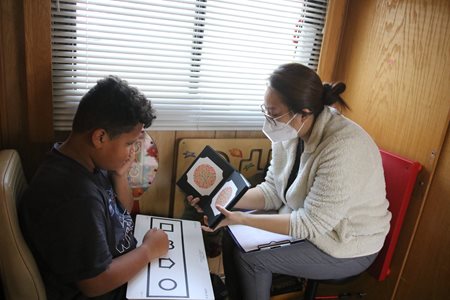What is Color Blindness?
Color blindness is an inability to see the difference between certain colors. Most people with color vision deficiency can see colors and the most common form of color deficiency is red-green. This does not mean that people with this deficiency cannot see these colors altogether, they simply have a harder time differentiating between them, which can depend on the darkness or lightness of the colors.
 Another form of color deficiency is blue-yellow. This is a rarer and more severe form of color vision loss than red-green deficiency because people with blue-yellow deficiency frequently have red-green blindness, too. In both cases, people with color-vision deficiency often see neutral or gray areas where color should appear. True color blindness in which everything is seen in shades of black and white is rare.
Another form of color deficiency is blue-yellow. This is a rarer and more severe form of color vision loss than red-green deficiency because people with blue-yellow deficiency frequently have red-green blindness, too. In both cases, people with color-vision deficiency often see neutral or gray areas where color should appear. True color blindness in which everything is seen in shades of black and white is rare.
Color vision deficiency is due to photoreceptors in the retina of the eye known as cones. These cones have light-sensitive pigments that enable us to recognize color. Each cone is sensitive to either red, green or blue light - long, medium or short wavelengths. The cones recognize these lights based on their wavelengths. Normally, the pigments inside the cones register different colors and send that information through the optic nerve to the brain. This enables us to distinguish countless shades of color. But if the cones don't have one or more light-sensitive pigments, they will be unable to see all colors.
Difficulties with color can be either inherited or acquired. Inherited color problems are much more common, especially in males, and do not change throughout life. Color blindness is more common than you might think. Approximately one in 12 men is color blind while only one in 200 women have the condition.
Acquired means that color blindness occurs later on in life. People can acquire color blindness in many ways, including:
- Age-related changes
- Eye diseases and injuries
- Certain medications
- Chemical toxicity
 In order to diagnose someone with color blindness, optometrists can use a variety of tests. One of the most common involves showing the patient circles containing many multi-colored dots that form a shape or number in the center. If the patient has typical color vision, they will be able to see a number or shape within the dots. If they are color blind or have a color vision anomaly, it will appear as if there is nothing present, or they might have a problem determining what the correct number or shape is. These and other tests can determine both the type and severity of color anomaly present.
In order to diagnose someone with color blindness, optometrists can use a variety of tests. One of the most common involves showing the patient circles containing many multi-colored dots that form a shape or number in the center. If the patient has typical color vision, they will be able to see a number or shape within the dots. If they are color blind or have a color vision anomaly, it will appear as if there is nothing present, or they might have a problem determining what the correct number or shape is. These and other tests can determine both the type and severity of color anomaly present.
There is no treatment for congenital color blindness. It usually does not cause any significant disability. However, there are special contact lenses and glasses that may help.
If you or someone you know has difficulty detecting certain colors, contact The Eye Institute today.